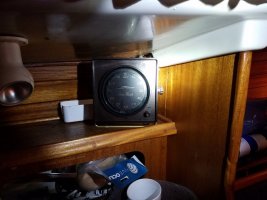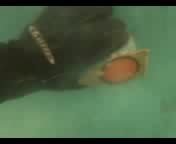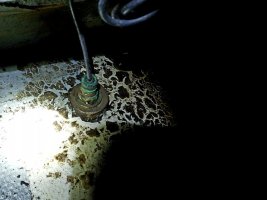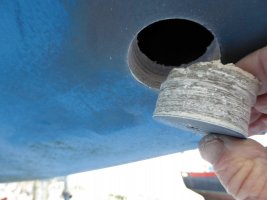DS trivia
The same forward "V" in the Ericson hull that makes for such a soft ride in rough seas, also makes a DS install a bit more complicated - up there in the bow.
It is desirable to have the face of the DS transducer parallel to the sea surface, and that's why the prior owner used a long-reach transducer thru a shaped piece of teak(?) on the outside of the hull.
This does create a couple of concerns, albeit low-percentage worries... one is that the protruding piece will be whacked by a piece of drift wood and knocked off or bent. The other is that it is large enough to slow the boat by several nano-knots.
I have done two installs where I glued the faced of the DS "puck" to the inside of the much flatter hull just behind the keel. As long as the angle is, say, under 5 or 6 degrees -give or take- your sound beam should still have a good shot down at the sea floor. Like my boat, yours has a solid layup hull, and the thickness will be less along the aft half of it.
Sand off the gel coat and clean the surface well with solvent first. If using the liquid-filled 'cup' provided by many major DS vendors it has a way to align it before it is glued down so that the actual face of the transducer is parallel to the water surface.
Otherwise you can epoxy the face to the inside of the hull.... but be really sure you have no air bubbles trapped in the thickened epoxy.

I note that many owners will put a small water-filled plastic bag against the hull, and hold the puck against the bag first -- just to verify that the instrument reads OK.
I note that some owners worry that locating the DS transducer aft will reduce the "warning" that the keel is about to costact the ground. Since you will normally be moving slowly when in shallow waters the difference in notice to you will be about a second, or less.
If moving at full speed, no matter where the transducer is located, you will not have enough time to effectively take an evasive maneuver anyhow....

Ask one of our members about the rock he nailed at warp speed! First 'notice' is usually the loud sound of the boat hitting something unyielding.
I have not hit a rock, but have grounded at about 7 kts in very hard sand. While we were aware of the nearing channel's edge, we did not allow for the steepness of the underwater ledge we could not see.
Buried our keel a full foot deep in a heart beat, and had to be towed off.
It's all good clean fun!









